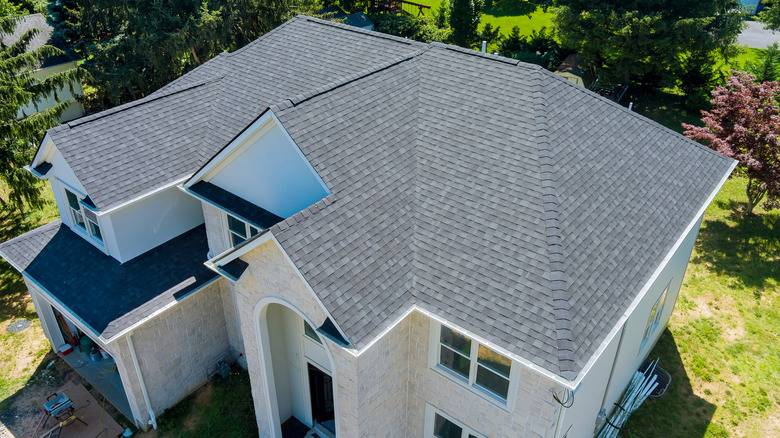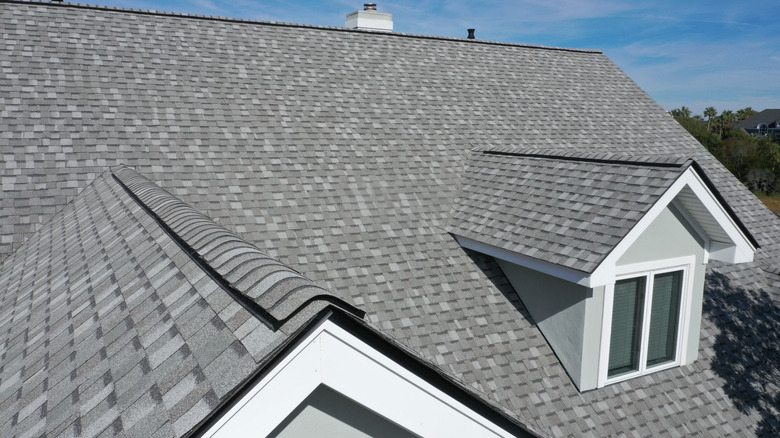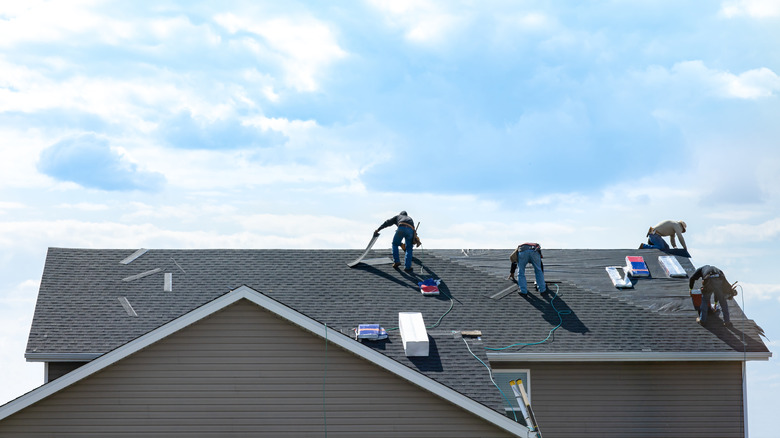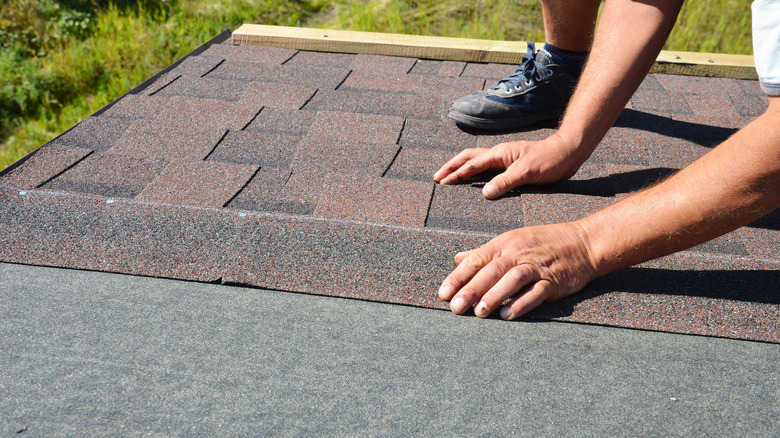What's The Length Of The Roof Reshingling Process?
Reapplying shingles to a roof can take time. Depending on the type of shingles you are planning to lay down, the average shingling job will run between one and two days for the easiest installation option and as many as nine days for concrete shingles or tiles to be installed, according to American Construction.
Selecting a type of shingle to install is about more than just timeframes, though. There are cost and durability considerations to think about, too. Likewise, on a much larger or smaller than average home, these times can be stretched out or condensed as a result of varying dimensions of the areas requiring coverage.
Selecting the type of roof to install as you prepare to replace an existing covering is a big decision. If you are simply repairing damages to a single section of the roof, you're likely constrained in your ability to make decisions here — likely opting for the same kind of shingles as are already present on the rest of the roof. However, a repair will cover a much smaller component of the total roof area and, as a result, shorten the length of time it takes to complete the installation.
Cenvar Roofing notes that some significant faults can start to take shape on top of the home once the shingles begin to fail. From leaks that make their way into the home to cracks in the shingles, keeping an eye on the state of your roof will help you make this decision much easier.
Identify the total area that requires reshingling
The first step to reshingling a roof is the preparation and measurement work that must naturally precede the actual installation process. Dumpsters reports that a roofing replacement typically costs between $4,700 and $10,460, with much of the difference in price coming as a result of both the type and quantity of shingles and other materials combined. The larger your roof is, the more material you will need to buy, as well as the labor costs resulting from increased time on the job.
Inspecting the roof for damages on a routine basis will help you maintain a sense of the overall replacement and repair needs of the surface. When replacing your roof, it may be possible to only target a section of the area. For example, this may be the case in the event of a recent home extension, resulting in a brand new segment of shingling alongside much older components.
Most roof replacements encompass the whole surface, though, so measuring out the amount of surface area that your roof incorporates is a must for understanding both the price and the amount of time that it will cost you to replace the installation.
Consider the weather in your area
Weather is a major factor in any roofing job, according to American Construction. The weather can be a fickle element that delays or even halts the progress of a roof installation for days at a time. Roofers start by removing the existing protective layer from your home, exposing the interior, in part, and the underside, in full, to the elements. Rain can hamper the effectiveness of an installation, and so roofers will try to work rapidly to finish off every job they perform in order to beat the changes in weather that can occur in any part of the country.
Above Roofing notes that rain (or even snow) can elongate the project in many ways. These environmental features reduce the effectiveness of bonding agents and can make the workspace unsafe for roofers to continue their tasks. The use of power tools to complete the installation means that rainwaters create an unfeasible work environment, and a wet roof can be immensely slippery (in addition to the poor working surface for the installation of shingles and adhesive itself).
Starting a job when rain is expected in the coming days can slow down a project. Similarly, your roofer might wait to start the installation of a new roof in order to wait out a present or coming rain system, delaying the project's completion in another way.
Understand the needs of your particular roof when selecting new shingles
The slope of your roof can limit the kinds of shingles that can be effectively installed on top of your home. Dumpsters notes that a roof with a steep slope isn't well suited to the installation of heavier, concrete shingles, for instance. While shingles are placed in an overlapping fashion and sealed, over time, they can come loose, creating a potential hazard in the process if the slope makes your installation prone to sliding and falling.
The type of shingles you choose for the new roof will often determine how long it takes to complete the job. Obviously, the removal process is a standard piece of the process, and shingle removal is fairly straightforward, occupying roughly the same amount of time on each new job that a roofer takes on. The installation varies dramatically based on a number of features of the home and environment, however.
The slope of your roof, odd corners that join together in wings or the center of the home, or overhanging sections that double up on one another in certain spaces can make the decision to choose a particular kind of shingle more direct. Likewise, these features of your unique roof can add to the time it might take to complete a roof installation, or the features might be conducive to a fast changeover.
Don't forget about your budget
Your budget is a crucial component in the reshingling process. Selecting appropriate shingles for your home and budget is part of the process, but the choice to use slate tiles, asphalt shingles, or wooden shingles (among other options), can dramatically influence the amount of time it takes to complete the work.
Above Roofing notes that asphalt shingles typically take one to three days to install, while concrete tiles require more than a week to finish working into place. Your budget will play a role in dictating what kind of shingles you ultimately decide to install for the new roof over your home and therefore acts as an integral component in determining the timeline for the replacement work.
It's important to speak with your roofing contractor about different options. This is true for a number of reasons and starts with an understanding of weather patterns in your area and the best type of roofing system to install for the environmental needs of your community. This could mean that your budget needs to be amended in order to provide for the appropriate type of installation or to support a faster installation to contend with overlapping emergency repairs and poor weather looming on the horizon.
Scheduling issues can delay the start of a reshingling job
Lastly, the schedule that your roofing contractor keeps might interfere with a quick reshingle job. Even with a simple roof layout, an easy-to-install shingle selection, and good weather, conducting a roof replacement during a busy month or season might bring in additional time constraints.
Roofers are immensely busy during the summer and fall, according to Angi, and this can delay the start or completion of a replacement or repair on any one of a roofer's clients' homes, including yours. In order to understand the timeline for replacement in its entirety, you'll want to talk with your roofer about ongoing constraints that might affect the job. The weather will play a large role in the speed by which your roof replacement progresses, but the realities of your roofer's schedule make up a significant consideration as well. Transparency and communication can help make sense of the timeline for replacement and give you the best experience possible with your roofing contractor.





